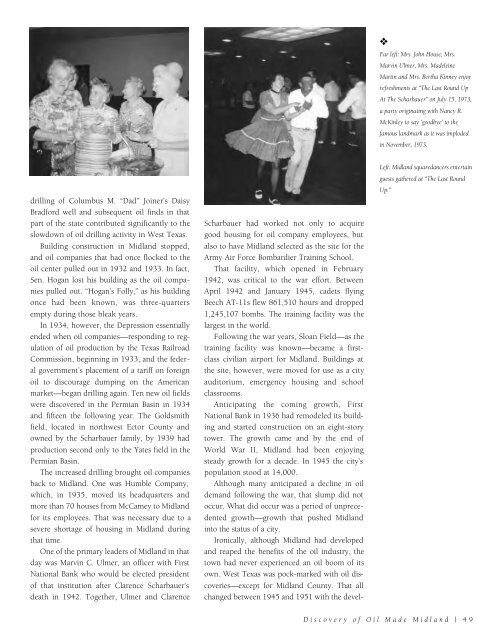Historic Midland
An illustrated history of the Midland County area, paired with the histories of companies, families and organizations that make the region great.
An illustrated history of the Midland County area, paired with the histories of companies, families and organizations that make the region great.
You also want an ePaper? Increase the reach of your titles
YUMPU automatically turns print PDFs into web optimized ePapers that Google loves.
❖<br />
Far left: Mrs. John House, Mrs.<br />
Marvin Ulmer, Mrs. Madeleine<br />
Martin and Mrs. Bertha Kinney enjoy<br />
refreshments at “The Last Round Up<br />
At The Scharbauer” on July 15, 1973,<br />
a party originating with Nancy R.<br />
McKinley to say ‘goodbye’ to the<br />
famous landmark as it was imploded<br />
in November, 1973.<br />
drilling of Columbus M. “Dad” Joiner’s Daisy<br />
Bradford well and subsequent oil finds in that<br />
part of the state contributed significantly to the<br />
slowdown of oil drilling activity in West Texas.<br />
Building construction in <strong>Midland</strong> stopped,<br />
and oil companies that had once flocked to the<br />
oil center pulled out in 1932 and 1933. In fact,<br />
Sen. Hogan lost his building as the oil companies<br />
pulled out. “Hogan’s Folly,” as his building<br />
once had been known, was three-quarters<br />
empty during those bleak years.<br />
In 1934, however, the Depression essentially<br />
ended when oil companies—responding to regulation<br />
of oil production by the Texas Railroad<br />
Commission, beginning in 1933, and the federal<br />
government’s placement of a tariff on foreign<br />
oil to discourage dumping on the American<br />
market—began drilling again. Ten new oil fields<br />
were discovered in the Permian Basin in 1934<br />
and fifteen the following year. The Goldsmith<br />
field, located in northwest Ector County and<br />
owned by the Scharbauer family, by 1939 had<br />
production second only to the Yates field in the<br />
Permian Basin.<br />
The increased drilling brought oil companies<br />
back to <strong>Midland</strong>. One was Humble Company,<br />
which, in 1935, moved its headquarters and<br />
more than 70 houses from McCamey to <strong>Midland</strong><br />
for its employees. That was necessary due to a<br />
severe shortage of housing in <strong>Midland</strong> during<br />
that time.<br />
One of the primary leaders of <strong>Midland</strong> in that<br />
day was Marvin C. Ulmer, an officer with First<br />
National Bank who would be elected president<br />
of that institution after Clarence Scharbauer’s<br />
death in 1942. Together, Ulmer and Clarence<br />
Scharbauer had worked not only to acquire<br />
good housing for oil company employees, but<br />
also to have <strong>Midland</strong> selected as the site for the<br />
Army Air Force Bombardier Training School.<br />
That facility, which opened in February<br />
1942, was critical to the war effort. Between<br />
April 1942 and January 1945, cadets flying<br />
Beech AT-11s flew 861,510 hours and dropped<br />
1,245,107 bombs. The training facility was the<br />
largest in the world.<br />
Following the war years, Sloan Field—as the<br />
training facility was known—became a firstclass<br />
civilian airport for <strong>Midland</strong>. Buildings at<br />
the site, however, were moved for use as a city<br />
auditorium, emergency housing and school<br />
classrooms.<br />
Anticipating the coming growth, First<br />
National Bank in 1936 had remodeled its building<br />
and started construction on an eight-story<br />
tower. The growth came and by the end of<br />
World War II, <strong>Midland</strong> had been enjoying<br />
steady growth for a decade. In 1945 the city’s<br />
population stood at 14,000.<br />
Although many anticipated a decline in oil<br />
demand following the war, that slump did not<br />
occur. What did occur was a period of unprecedented<br />
growth—growth that pushed <strong>Midland</strong><br />
into the status of a city.<br />
Ironically, although <strong>Midland</strong> had developed<br />
and reaped the benefits of the oil industry, the<br />
town had never experienced an oil boom of its<br />
own. West Texas was pock-marked with oil discoveries—except<br />
for <strong>Midland</strong> County. That all<br />
changed between 1945 and 1951 with the devel-<br />
Left: <strong>Midland</strong> squaredancers entertain<br />
guests gathered at “The Last Round<br />
Up.”<br />
Discovery of Oil Made <strong>Midland</strong> | 49
















